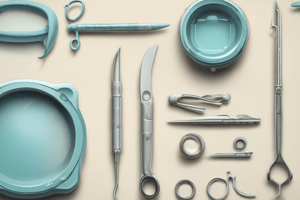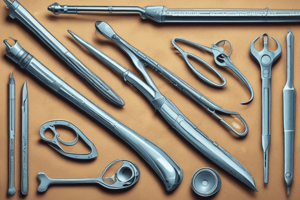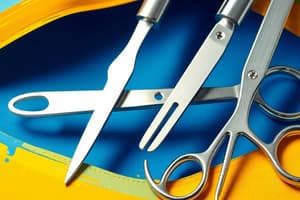Podcast
Questions and Answers
What is the primary responsibility of CSSD technicians/specialists?
What is the primary responsibility of CSSD technicians/specialists?
- To perform surgical procedures on patients
- To purchase new surgical instruments for the healthcare facility
- To design and invent new surgical instruments
- To ensure surgical instruments are safe, functional, and available when needed (correct)
Which of the following statements is true regarding surgical instruments?
Which of the following statements is true regarding surgical instruments?
- All surgical instruments serve the same general purpose
- Similar-looking instruments can be used interchangeably for any procedure
- The size and type of instrument used in a procedure are not important factors
- Each instrument is designed to perform a specific function in a specific situation (correct)
What is the primary reason for the exacting instrument requirements in surgical procedures?
What is the primary reason for the exacting instrument requirements in surgical procedures?
- To accommodate the surgeon's personal preferences
- To account for the complexity of the human body and the need for precise instruments (correct)
- To comply with strict regulatory guidelines
- To ensure the instruments are aesthetically pleasing
What is one of the sources for the names of surgical instruments?
What is one of the sources for the names of surgical instruments?
What is the process followed by CSSD technicians/specialists for preparing surgical instruments?
What is the process followed by CSSD technicians/specialists for preparing surgical instruments?
Which material was predominantly used for surgical instruments during the Middle Ages?
Which material was predominantly used for surgical instruments during the Middle Ages?
Who is considered the 'Father of Modern Surgery' and made significant advancements in surgical instruments during the Islamic Golden Age?
Who is considered the 'Father of Modern Surgery' and made significant advancements in surgical instruments during the Islamic Golden Age?
What development in the Twentieth and Twenty-First Centuries enabled more possibilities for internal surgical procedures?
What development in the Twentieth and Twenty-First Centuries enabled more possibilities for internal surgical procedures?
According to the FDA guidance on reprocessing medical devices, what aspect did it emphasize regarding instrument design?
According to the FDA guidance on reprocessing medical devices, what aspect did it emphasize regarding instrument design?
Which of the following is NOT mentioned as a disadvantage of disposable surgical instruments in the given text?
Which of the following is NOT mentioned as a disadvantage of disposable surgical instruments in the given text?
Flashcards
Surgical Instrument Management
Surgical Instrument Management
The process of cleaning, decontaminating, packing, and sterilizing instruments to ensure safety, functionality, and availability.
Instrument Origin
Instrument Origin
Instruments are designed by physicians for specific purposes and named after their function or inventor.
Reusable Instruments
Reusable Instruments
Durable, hard metal surgical tools that can be repeatedly sterilized and used.
Disposable Instruments
Disposable Instruments
Signup and view all the flashcards
CSSD/CSD Technician Role
CSSD/CSD Technician Role
Signup and view all the flashcards
Instrument Inspection
Instrument Inspection
Signup and view all the flashcards
Instrument Assembly
Instrument Assembly
Signup and view all the flashcards
Surgical Instrument History
Surgical Instrument History
Signup and view all the flashcards
Early Surgical Instruments
Early Surgical Instruments
Signup and view all the flashcards
Instrument Sterilization
Instrument Sterilization
Signup and view all the flashcards
Study Notes
Surgical Procedures and Instruments
- Millions of surgical procedures are performed in the kingdom each year, requiring billions of surgical instruments to be processed annually.
- CSSD/CSD technicians/specialists play a crucial role in ensuring that instruments are safe, functional, and available when needed.
Instrument Management
- Cleaning, decontaminating, packing, and sterilizing instruments are critical steps in the process.
- Identifying and inspecting instruments is vital to ensure they are in good condition.
- Instrument assembly is another crucial role for CSSD.
Instrument Origin and Design
- Physicians identify specific instruments needed for various procedures.
- Most instruments are purchased by healthcare facilities and maintained by CSSD, while some are loaned for specific surgeries.
- Instruments are designed to perform specific functions in specific situations and are named after their anatomical location or inventor.
Reusable vs Disposable Instruments
- Reusable instruments: durable, hard metal components, repeated reprocessing (months-years), but costly, prone to cross-contamination, and require maintenance.
- Disposable instruments: prevent cross-contamination, reduce human error, safe, and time-saving, but less durable and require reprocessing.
History of Surgical Instruments
- Prehistory (3,500 BC): earliest surgical instruments were teeth and hands, used with natural materials.
- Antiquity (600 BC - 300 AD): Hippocrates introduced surgical instruments made of bronze and iron.
- The Middle Ages (500 - 1500): medieval artisans crafted instruments from iron, steel, and wood.
- Arabic (1000 AD): Abu al-Qasim Al-Zahrawi introduced over 200 surgical instruments, becoming the father of modern surgery.
- The Renaissance (15th century): the invention of the printing press allowed for faster dissemination of ideas, leading to the development of new instruments.
- The Twentieth & Twenty-First Centuries: surgical instruments evolved from stone to stainless steel, with the practice of sterilization enabling more internal surgical procedures.
Studying That Suits You
Use AI to generate personalized quizzes and flashcards to suit your learning preferences.




